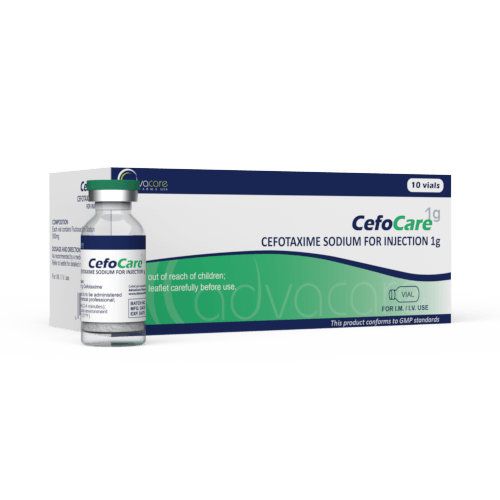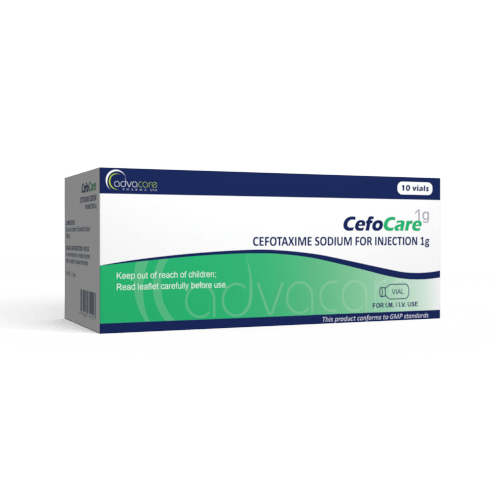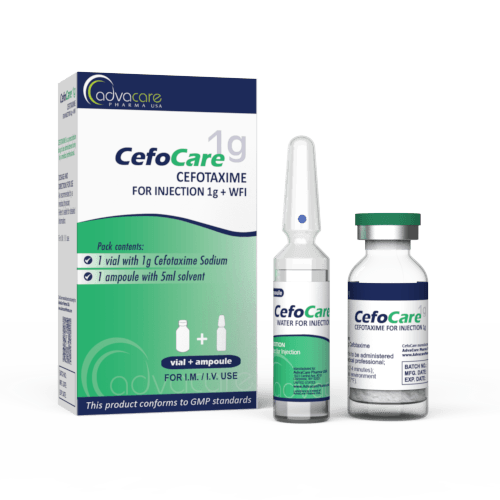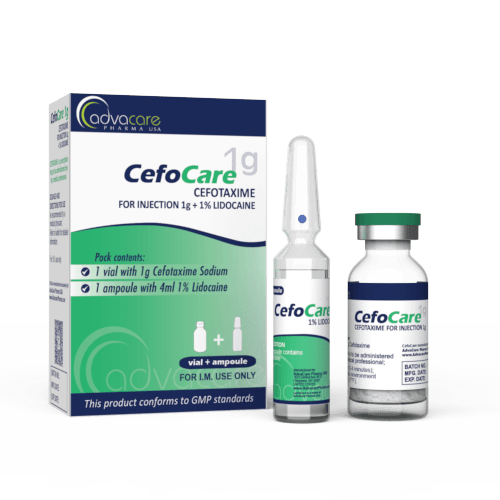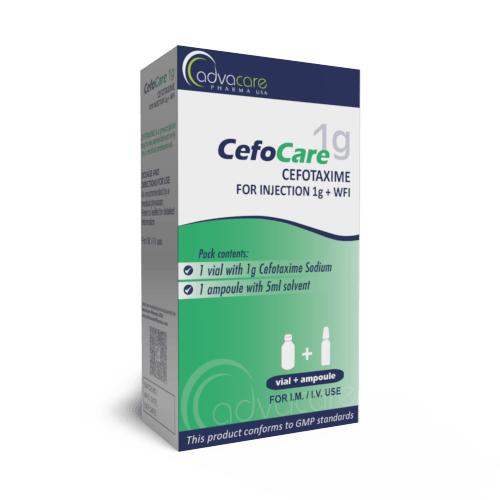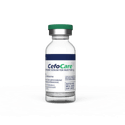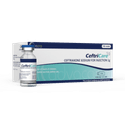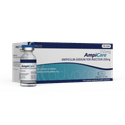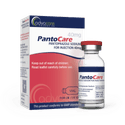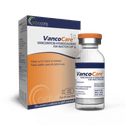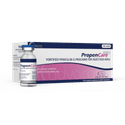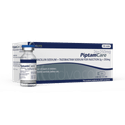- Home›
- Pharmaceuticals›
- Injections›
- Powder for Injection›
- Cefotaxime Sodium for Injection
Cefotaxime Sodium for Injection
Dosage
Packaging
What is Cefotaxime Sodium?
Active Ingredients: Cefotaxime Sodium
Cefotaxime Sodium for Injection is an antibiotic used to treat many types of bacterial infections. It is indicated for the treatment of infections such as lower respiratory tract infections, joint infections, urinary tract infections, gonorrhea, pelvic inflammatory disease, meningitis, and sepsis.
Cefotaxime is classified as a cephalosporin antibiotic. It works by inhibiting cell wall synthesis within the bacteria. This antibiotic belongs to the third generation of cephalosporins and is extremely effective against Enterobacteriaceae, Neisseria spp., and H.influenzae.
Bacteria in affected organisms synthesize a cell wall, which is strengthened by penicillin-binding proteins. Cephalosporins are derived from the fungus Cephalosporium sp. and it works via its beta-lactam ring, which binds to the penicillin-binding protein. This causes inhibition of its normal bacteria activity. The bacteria are no longer able to synthesize a cell wall, and the bacteria die.
Staphylococcus aureus can develop resistance to this antibiotic by changing the penicillin-binding proteins. This is done by a gene that encodes a modified penicillin-binding protein. That is what makes the antibiotic unable to inactivate the bacteria-binding protein. Bacteria that become resistant to cephalosporins are called methicillin-resistant Staphylococcus aureus (MRSA). This antibiotic belongs to the third generation of cephalosporins and does not have coverage against MRSA.
This drug should be applied parenterally and there are three ways of administration, including intramuscular injection and intravenous injection or infusion. After reconstitution, the solution should be injected intravenously after 3-5 minutes, while the prepared infusion can be administered after 20-60 minutes. Intramuscular injections should be deeply injected into the muscles. Intramuscular injections can be effective in treating gonococcal infections and its complications.
After administration, cefotaxime penetrates well into most body fluids and extracellular fluids, especially in cases of inflammation. Cefotaxime can even reach the cerebrospinal fluid and be effective in the treatment of meningitis.
This antibiotic is excreted through urine, and the doses must be adjusted properly, especially in humans with renal insufficiencies. After administration, approximately 20-36% of the intravenous cefotaxime is excreted unchanged, while 15-25% is a desacetyl derivative, which contributes to the bactericidal activity. Other urinary metabolites are M2 and M3, which lack bactericidal activity. The half-life of this antibiotic is very short and it is approximately 1 hour.
This product is available in three different packaging options: a vial with Cefotaxime, a Cefotaxime vial accompanied by a separate ampoule of Water for Injection (WFI) for reconstitution, and a Cefotaxime vial paired with a Lidocaine ampoule as a solvent for the reconstitution process. Lidocaine is used as a solvent to provide an anesthetic effect during administration.
AdvaCare Pharma is a global distributor and producer of Cefotaxime for Injection. Our medical products are manufactured in GMP-certified facilities in China, India, and the USA. These factories are routinely inspected to ensure they meet the high standards necessary to comply with WHO guidelines and standards.
Why choose us as your Cefotaxime manufacturer?
AdvaCare Pharma, a US-owned pharmaceutical company, is a manufacturer of Cefotaxime for Injection with GMP-compliant manufacturing facilities located worldwide. We conduct frequent GMP, third-party and internal facility inspections to ensure that our manufactured injectable treatments exceed the stringent requirements of importing countries and our distributors.
As a renown Cefotaxime manufacturer and global supplier of 120+ pharmaceutical injection products, our global reach extends to over 65 markets ensuring that pharmaceutical distributors, hospitals, pharmacies, NGOs and government institutions receive the quality-assured treatments they need.
Uses
What is Cefotaxime Sodium used for?
It is used to treat bacterial infections such as:
It is also used as a perioperative prophylaxis.
How is Cefotaxime Sodium for Injection used?
This medication is manufactured as a powder, which is packaged in a vial. It is to be administered into a vein or muscle after reconstitution.
What dose should be given?
Recommendations of dosage are based on the severity of the infections, age, sex, and body weight:
- For mild to moderate infections, the usual dose for adults is 1g, given every 12 hours.
- For severe infections, the usual dose may be increased up to 12g, divided and given in 3-4 doses.
- For infections caused by Pseudomonas, the usual dose is greater than 6g.
- For children, the usual dose is 100-150mg/kg per day, divided and given in 2-4 doses.
- For neonates, the usual dose is 50mg/kg per day, divided and given in 2-4 doses.
Who can use Cefotaxime Sodium for Injection?
Cefotaxime Sodium can be administered to adults, children, and neonates who are suffering from bacterial infections. It can also be used as a perioperative prophylaxis. Caution is advised for specific groups of patients.
Pregnant Cephalosporins are considered safe during pregnancies. This drug belongs to the category B pregnancy risk. There are no well-controlled studies in pregnant women that give information about the drug’s risk. It should be used only if the benefits outweigh the risks to the fetus.
Nursing This drug can enter the breast milk, and it is excreted through it. This might alter the bowel microbiota of the infants. However, some studies show that Cefotaxime is beneficial in treating perinatal infections, and during the treatment process, there were no negative effects on mothers and infants.
Pediatric Cefotaxime is the first drug of choice of cephalosporins for treating pediatric infections. According to studies, IV or IM administration of cefotaxime can cure or improve 97% of the patients and eradicate 94% of the pathogens without causing toxicity or severe side effects. This result can be achieved if the doses are adequate.
Geriatric Older patients have greater sensitivity to any drug, and special caution must be taken when giving this drug to older people. Patients with acute renal illnesses might have difficulties when metabolizing the drug, and proper dose adjustments are required.
There is also a possibility for increased diarrhea due to Clostridium difficile after administering Cefotaxime in older patients. Geriatric patients must be monitored properly when administering Cefotaxime.
Is Cefotaxime Sodium for Injection suitable for treating viral infections?
No, Cefotaxime is classified as an antibiotic from the cephalosporin group of antibiotics, and it is used for treating bacterial infections. It works by impacting the bacterial cell wall when given. However, some viral infections might lead to secondary infections, including bacterial infections, and Cefotaxime might be useful in these situations. If the bacteria are susceptible to Cefotaxime, this drug can be helpful in the treatment process of combined infections (bacterial and viral), but it will address only the bacteria.
Other warnings
Different health conditions require different dosing. Patients with mild infections should receive lower doses than those suffering from severe infections. In patients with renal impairment, it is crucial to adjust the dose. If the patient has a history of major hypersensitivity to other cephalosporins, doctors should avoid this drug. Also, patients allergic to penicillins might have cross-reactivity with cephalosporins.
Almost all antibiotics might lead to diarrhea and destroy the beneficial gut microorganisms. Patients may consider discussing the potential benefits of probiotic supplementation during antibiotic treatment with their healthcare provider.
Side Effects
As with all pharmaceuticals, some unwanted effects can occur from the use of Cefotaxime Sodium for Injection.
Common side effects include, but may not be limited to: • swelling, redness, or pain at the injection site • diarrhea • rash or itching • fever
Serious side effects may occur. Seek medical attention if the following develop: • watery or bloody stools, which may appear months after the final injection • burning or skin changes at the injection site • jaundice, dark urine, or other liver-related problems • seizures
Significant adverse effects of cephalosporins include: • hypersensitivity reactions • Clostridium difficile induced diarrhea • leukopenia • thrombocytopenia • positive Coombs test
Any antibiotic might lead to pseudomembranous colitis, but cephalosporins have a broad spectrum, and the risk is higher. The risk is the highest in patients with inadequate doses who use the same antibiotic for a prolonged period of time. In case of suspected colitis, the doctor should stop the treatment process. Patients with antibiotic-induced colitis need a specific antibiotic therapy.
For a comprehensive understanding of all potential side effects, consult a medical professional.
If any symptoms persist or worsen, or you notice any other symptoms, please call your doctor.
Precautions
Do NOT use Cefotaxime Sodium for Injection if:
- You are hypersensitive or allergic to any of the ingredients.
- You are pregnant.
- You have a medical history of severe heart failure.
Cefotaxime might enter the breast milk and alter the infant’s bowel microbiota. Most doctors do not recommend usage during breastfeeding. There is little evidence with regards to the use of Cefotaxime Sodium during breastfeeding, so consult a doctor or healthcare professional before treatment with Cefotaxime Sodium.
Before treatment, consult your doctor regarding any medications you are taking to address potential drug interactions.
Patients with low glomerular filtration should receive lower doses of Cefotaxime.
Blood tests should be performed if the treatment process lasts more than 7 days because Cefotaxime might lead to leukopenia and thrombocytopenia. This antibiotic might also affect the results of some laboratory tests.
Cefotaxime, in combination with lidocaine, should never be used intravenously in infants.
This medication may not be suitable for people with certain conditions, so it is important to consult with a doctor if you have any health conditions.
Patients treated with Cefotaxime should not consume alcohol.
Some humans might experience dizziness or drowsiness while performing mental activities, like driving.
This antibiotic should be used only when prescribed by a professional.
Keep this antibiotic out of reach of children.
References
Cefotaxime in the treatment of lower respiratory tract infections
This study examined the usefulness of cefotaxime in a clinical trial in 50 elderly patients with bacterial lower respiratory tract infections. The patients received 1g for two or four times per day.
The most common isolated bacteria were Streptococcus pneumoniae, Klebsiella, Staphylococcus aureus, and Haemophilus influenzae. The results showed that 44 patients (88%) were cured.
The conclusion of this study is that Cefotaxime has high efficacy in patients with respiratory tract infections.
You might be interested in...
Why AdvaCare Pharma?
As an industry leader, we are aware of our responsibility to provide affordable and sustainable solutions to improve healthcare worldwide.
